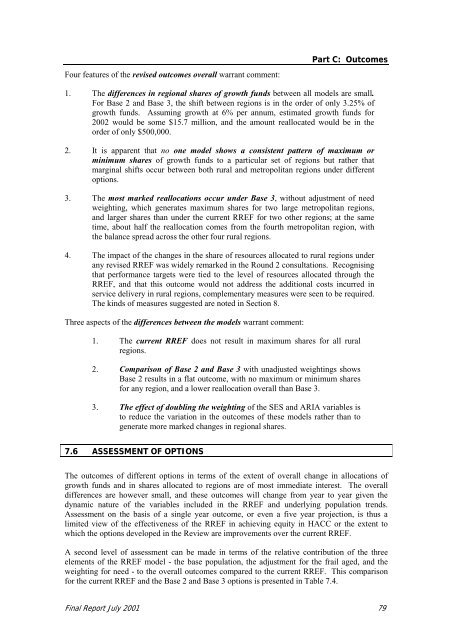Final Report on RREF 2001 - Department of Health
Final Report on RREF 2001 - Department of Health
Final Report on RREF 2001 - Department of Health
You also want an ePaper? Increase the reach of your titles
YUMPU automatically turns print PDFs into web optimized ePapers that Google loves.
Four features <strong>of</strong> the revised outcomes overall warrant comment:<br />
Part C: Outcomes<br />
1. The differences in regi<strong>on</strong>al shares <strong>of</strong> growth funds between all models are small.<br />
For Base 2 and Base 3, the shift between regi<strong>on</strong>s is in the order <strong>of</strong> <strong>on</strong>ly 3.25% <strong>of</strong><br />
growth funds. Assuming growth at 6% per annum, estimated growth funds for<br />
2002 would be some $15.7 milli<strong>on</strong>, and the amount reallocated would be in the<br />
order <strong>of</strong> <strong>on</strong>ly $500,000.<br />
2. It is apparent that no <strong>on</strong>e model shows a c<strong>on</strong>sistent pattern <strong>of</strong> maximum or<br />
minimum shares <strong>of</strong> growth funds to a particular set <strong>of</strong> regi<strong>on</strong>s but rather that<br />
marginal shifts occur between both rural and metropolitan regi<strong>on</strong>s under different<br />
opti<strong>on</strong>s.<br />
3. The most marked reallocati<strong>on</strong>s occur under Base 3, without adjustment <strong>of</strong> need<br />
weighting, which generates maximum shares for two large metropolitan regi<strong>on</strong>s,<br />
and larger shares than under the current <strong>RREF</strong> for two other regi<strong>on</strong>s; at the same<br />
time, about half the reallocati<strong>on</strong> comes from the fourth metropolitan regi<strong>on</strong>, with<br />
the balance spread across the other four rural regi<strong>on</strong>s.<br />
4. The impact <strong>of</strong> the changes in the share <strong>of</strong> resources allocated to rural regi<strong>on</strong>s under<br />
any revised <strong>RREF</strong> was widely remarked in the Round 2 c<strong>on</strong>sultati<strong>on</strong>s. Recognising<br />
that performance targets were tied to the level <strong>of</strong> resources allocated through the<br />
<strong>RREF</strong>, and that this outcome would not address the additi<strong>on</strong>al costs incurred in<br />
service delivery in rural regi<strong>on</strong>s, complementary measures were seen to be required.<br />
The kinds <strong>of</strong> measures suggested are noted in Secti<strong>on</strong> 8.<br />
Three aspects <strong>of</strong> the differences between the models warrant comment:<br />
1. The current <strong>RREF</strong> does not result in maximum shares for all rural<br />
regi<strong>on</strong>s.<br />
2. Comparis<strong>on</strong> <strong>of</strong> Base 2 and Base 3 with unadjusted weightings shows<br />
Base 2 results in a flat outcome, with no maximum or minimum shares<br />
for any regi<strong>on</strong>, and a lower reallocati<strong>on</strong> overall than Base 3.<br />
3. The effect <strong>of</strong> doubling the weighting <strong>of</strong> the SES and ARIA variables is<br />
to reduce the variati<strong>on</strong> in the outcomes <strong>of</strong> these models rather than to<br />
generate more marked changes in regi<strong>on</strong>al shares.<br />
7.6 ASSESSMENT OF OPTIONS<br />
The outcomes <strong>of</strong> different opti<strong>on</strong>s in terms <strong>of</strong> the extent <strong>of</strong> overall change in allocati<strong>on</strong>s <strong>of</strong><br />
growth funds and in shares allocated to regi<strong>on</strong>s are <strong>of</strong> most immediate interest. The overall<br />
differences are however small, and these outcomes will change from year to year given the<br />
dynamic nature <strong>of</strong> the variables included in the <strong>RREF</strong> and underlying populati<strong>on</strong> trends.<br />
Assessment <strong>on</strong> the basis <strong>of</strong> a single year outcome, or even a five year projecti<strong>on</strong>, is thus a<br />
limited view <strong>of</strong> the effectiveness <strong>of</strong> the <strong>RREF</strong> in achieving equity in HACC or the extent to<br />
which the opti<strong>on</strong>s developed in the Review are improvements over the current <strong>RREF</strong>.<br />
A sec<strong>on</strong>d level <strong>of</strong> assessment can be made in terms <strong>of</strong> the relative c<strong>on</strong>tributi<strong>on</strong> <strong>of</strong> the three<br />
elements <strong>of</strong> the <strong>RREF</strong> model - the base populati<strong>on</strong>, the adjustment for the frail aged, and the<br />
weighting for need - to the overall outcomes compared to the current <strong>RREF</strong>. This comparis<strong>on</strong><br />
for the current <strong>RREF</strong> and the Base 2 and Base 3 opti<strong>on</strong>s is presented in Table 7.4.<br />
<str<strong>on</strong>g>Final</str<strong>on</strong>g> <str<strong>on</strong>g>Report</str<strong>on</strong>g> July <strong>2001</strong> 79
















